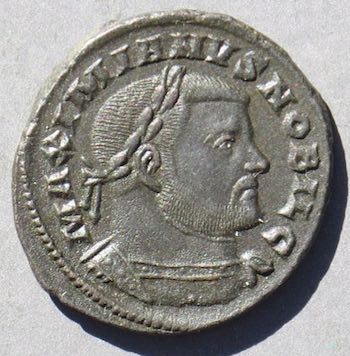 Distinguishing between Maximian, Galerius, and Maximinus II.
Distinguishing between Maximian, Galerius, and Maximinus II.
Their legends can be very similar. Both Maximian and Galerius used "MAXIMIANVS" in their legends. The coin to the right is of Galerius even though it says "MAXIMIANVS". Read on to understand why. Maximinus II used "MAXIMINVS", which differs by only one easy-to-overlook letter (Two coins).
Dates:
Maximian (= Maximianus, abbreviated for English like "Marcus" Antony becomes "Marc") was Augustus 286-305 (with a second reign 306-308 in the west).
Galerius was Caesar 293-305 and Augustus 305-311.
Maximinus II was Caesar 305-310 and Augustus 310-313. (The first Maximinus was emperor 235-238.)
The Cause of the Problem. The emperor we call Maximian was named
Marcus Aurelius Valerius Maximianus (see the next coin).
The name of Galerius was
Gaius Galerius Valerius Maximianus, which is similar. We use "Maximian" or "Maximianus" for the first, so scholars have chosen to use a different name, Galerius, for the second. (Maybe he could have been called Maximianus II, but he is not.)
Emperor Maximinus II was
Galerius Valerius Maximinus, which is not much different, lacking only the second "A" in "MAXIMIANVS".
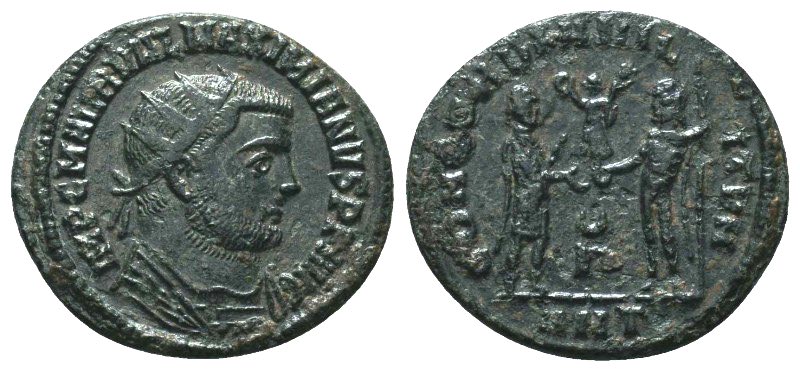
Maximian
20 mm. 2.70 grams. A "radiate fraction."
IMP C M AVR VAL MAXIMIANVS PF AVG.
Marcus AVRelius VALerius Maximianus
The long version of his name on a radiate fraction minted at Antioch.
Most of his legends are much more abbreviated.
RIC VI Antioch 60b "c. 296"
In contrast, many coins of Galerius and of Maximinus II have "GAL VAL" in their legends, as seen below.
What's new? 2020, August 30: A coin of Maximian with the long version of his name (just above).
2020, March 20: Galerius as Augustus, HERCVLI VICTORI.
So, how do we tell their coins apart? This is not trivial. Details matter.
All the coins have legends with
MAXIMIANVS (for both Maximian and Galerius, so we need something else to distinguish them, often "GAL" in the legend)
or
MAXIMINVS (uniquely determines Maximinus II, but it can be hard to notice the difference in a long legend when all the rest is identical).
Advice 1: Don't assume "MAXIMIANVS" identifies Maximianus. (You must read the rest of the legend; it might be Galerius.)
Advice 2: Read carefully enough to distinguish between "MAXIMIANVS" and "MAXIMINVS."
Rule 1: MAXIMINVS always identifies Maximinus II. (Maximinus I was much earlier, AD 235-238. His coins did not look at all like these.)
Rule 2: MAXIMIANVS with CAES identifies Galerius.
Rule 3: MAXIMIANVS with GAL identifies Galerius.
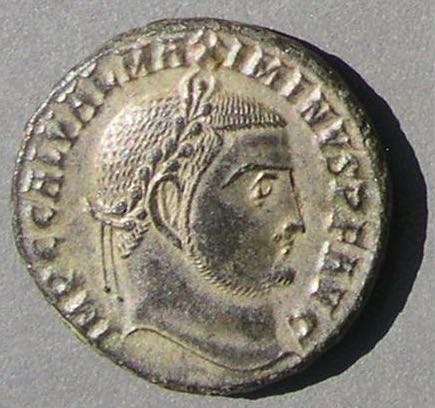
Example of Rule 1: MAXIMINVS always identifies Maximinus II.
GAL(erius) VAL(erius) was part of the name of both Galerius and Maximinus II. Look carefully and you will see
IMP C GAL VAL MAXIMINVS PF AVG
with MAXIMINVS instead of MAXIMIANVS. [The letter "A" is missing at 1:30.]
MAXIMINVS makes it Maximinus II.
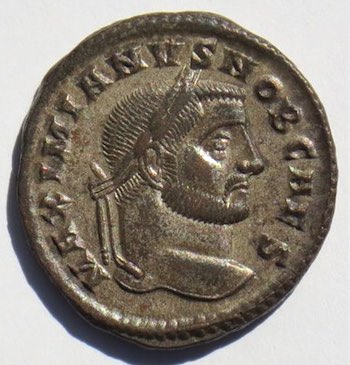
Example of Rule 2: MAXIMIANVS with CAES identifies Galerius.
MAXIMIANVS NOB CAES
This is a coin of Galerius. Recall Advice 1: Don't assume "MAXIMIANVS" identifies Maximian.
All coins of Maximian have the title "Augustus," so this coin can't be of Maximian. However, Galerius also issued coins as Augustus, so "MAXIMIANVS" and "AVG" do not assure the coin is of Maximian. See the next coin.
Two ancient sources (Panegyri Latani 10(2) and Eutropius, Breviarum, IX, 20), say that Diocletian made Maximian Caesar (mid 285) and later Augustus (early 286; the precise dates are disputed), so there was a time period when Maximian had the title Caesar but not the title Augustus. Nevertheless, scholars have identified no coins of Maximian without the title Augustus. Coins in that period must have been minted in the name of Diocletian only. If it were just coins, we would think Maximian had been promoted straight to Augustus. (I wonder if the ancient sources were wrong?)
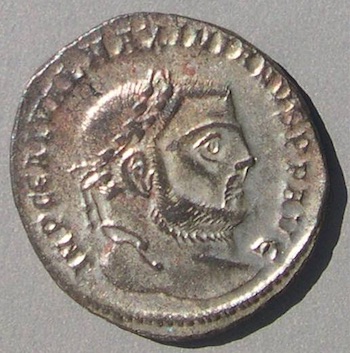
Example of Rule 3: MAXIMIANVS with GAL identifies Galerius.
IMP C GAL VAL MAXIMIANVS PF AVG
Galerius had "Galerius" as part of his name and Maximian did not. Coins with "MAXIMIANVS" in the legend are of Galerius if the legend includes "GAL" (for Galerius) as here with "GAL VAL".
The legend on the first coin is extremely similar. Here is the first coin again:
Recall Advice 2: Read carefully enough to distinguish between "MAXIMIANVS" and "MAXIMINVS" and Rule 1: MAXIMINVS always identifies Maximinus II.
GAL(erius) VAL(erius) was also part of the name of the emperor we call Maximinus II. Look carefully and you will see
MAXIMINVS instead of MAXIMIANVS. [The letter "A" is missing at 1:30.]
This coin is of Maximinus II. (Also, his coins tend to be a bit smaller in diameter because he became Augustus a few years later and inflation had made coins smaller.)
IMP C GAL VAL MAXIMINVS PF AVG is the legend here and
IMP C GAL VAL MAXIMIANVS PF AVG is the legend of the previous coin. Note that the long legend is identical with that of the previous coin except for the missing "A". For another pair of legends where these two emperors could be confused, see below.
What About Identifying Maximian?
Coins of Maximian have "MAXIMIANVS" in the legend but that is not enough to identify him. His name includes "Marcus Aurelius" and Galerius's name does not, which yields Rule 4.
Rule 4: Coins with "MA" and "MAXIMIANVS" are of Maximian.
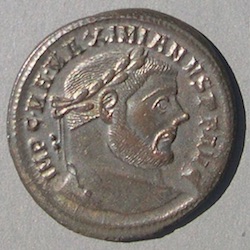
This coin has "MA" at 9:30. The coin is of Maximianus.
IMP C MA MAXIMIANVS PF AVG ("C" for Caesar and "MA" for Marcus Aurelius)
(The upturned nose unique to Maximian also identifies Maximian.)
Unfortunately, many coins of Maximian do not have "MA" on them.
Rule 5: Both Maximian and Galerius have coins with "MAXIMIANVS" and "AVG." We need some other way to tell them apart (sometimes the reverse type).
The next legend is IMP MAXIMIANVS PF AVG (Advice 2 told us to read it carefully!) "MAXIMIANVS" makes it either Maximianus or Galerius as Augustus. The one on the left is of Maximianus as we can tell only because its reverse (not pictured here) is shared with emperors before Galerius became Augustus in 305 (and by the portrait). The coin on its right has exactly the same legend, but it is of Galerius, as we can tell because the reverse (which is different and not pictured here) is shared with later emperors after Galerius became Augustus (and by the portrait). The legend does not distinguish them!
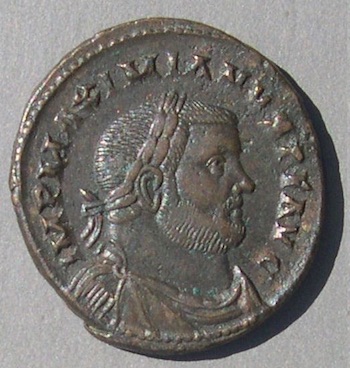
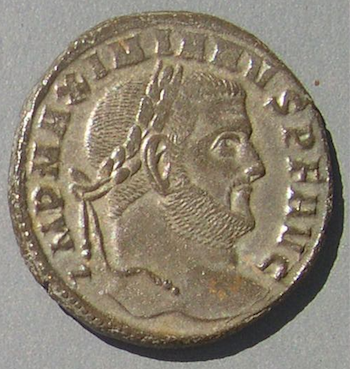
They are distinguished using a good reference work like Roman Imperial Coinage which identifies reverse types.
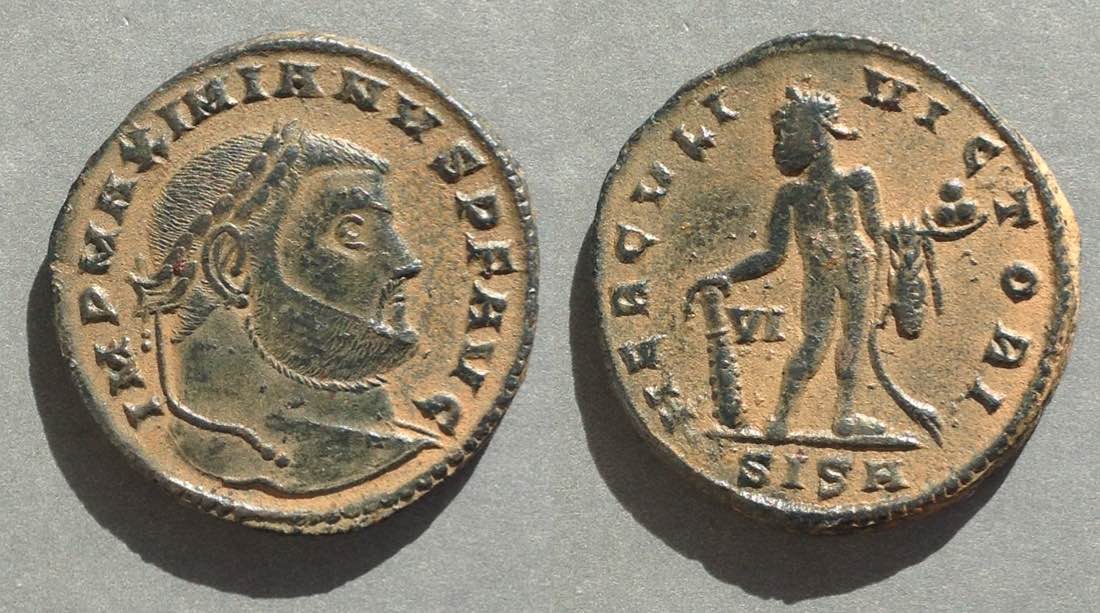
This HERCVLI VICTORI type was issued by both Maximian and Galerius. However, this issue from Siscia has "VI" in the left field, a mark that is shared with Constantius as Augustus and Maixminus II as Caesar, which proves this is a Second-Tetrarcy issue and this "MAXIMIANVS" must be Galerius.
RIC VI Siscia 165b.
Usually telling them apart is not so tricky. Legends of Galerius often have "GAL VAL" before "MAXIMIANVS" and are identified as Galerius by Rule 3. Maximian did not have "Galerius" as part of his name so his coins never have "GAL". Maximian had an upturned or bulbous nose which is a sure identifier. However, take Advice 2 ("Read carefully") because legends Maximinus II also have "GAL" and differ from those of Galerius by only a single missing A-- MAXIMINVS instead of MAXIMIANVS.
You may quit here. That's all the rules. Read further only if you want to see more examples.
Go to the page on portraits.
Distinguishing Maximianus and Galerius. Both always have "MAXIMIANVS."
Rule 2: MAXIMIANVS with CAES identifies Galerius.
Maximianus was never Caesar on coins, so coins with "NOB CAES" or "NOB C" cannot be of Maximian.
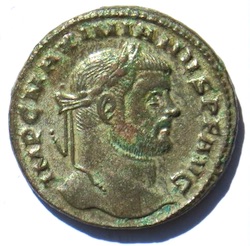

Both coins above have "MAXIMIANVS" in their legends. The second is as Caesar (NOB CAES) and therefore is of Galerius. The one on the left is of Maximian (note the nose again). However, Galerius became Augustus in 305 so some of his coins (the later ones) are as Augustus so "AVG" does not necessarily make the coin belong to Maximian.
Rule 1: MAXIMINVS always identifies Maximinus II.
Next is another example of Advice 2: Read carefully enough to distinguish between "MAXIMIANVS" and "MAXIMINVS."
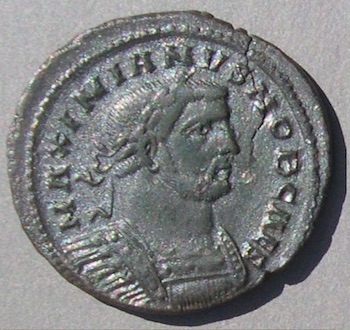
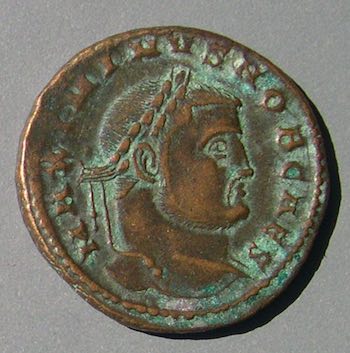 Coins with GAL VAL can be of Galerius or of Maximinus II. They are of Galerius if "MAXIMIANVS" really does have its "A", and they are of Maximinus II if it does not. The one on the left has "MAXIMIANVS NOB CAES" and is of Galerius. The one on the right has "MAXIMINVS NOB CAES" and is of Maximinus II. We know the one on the left is not Maximian (in spite of saying MAXIMIANVS) by Rule 2: MAXIMIANVS with CAES identifies Galerius.
Coins with GAL VAL can be of Galerius or of Maximinus II. They are of Galerius if "MAXIMIANVS" really does have its "A", and they are of Maximinus II if it does not. The one on the left has "MAXIMIANVS NOB CAES" and is of Galerius. The one on the right has "MAXIMINVS NOB CAES" and is of Maximinus II. We know the one on the left is not Maximian (in spite of saying MAXIMIANVS) by Rule 2: MAXIMIANVS with CAES identifies Galerius.
Next is another example of Advice 2: Read carefully enough to distinguish between "MAXIMIANVS" and "MAXIMINVS."
Sometimes coins of Galerius have "GAL" in the legend and coins of Maximianus never do, but many coins of Maximinus II also have "GAL" in the legend. The next legend on the left begins "GAL VAL" (Galerius Valerius) which could belong to Galerius or to Maximinus II. Which one is it? How does it differ from the one on the right?
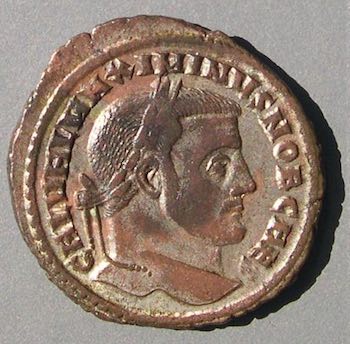
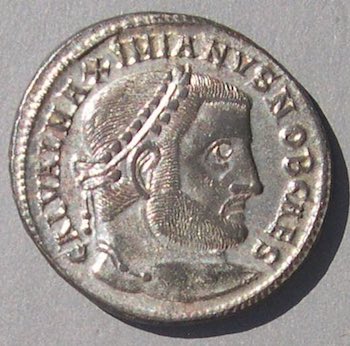
The precise spelling is important. The one on the left reads "MAXIMINVS" missing only the "A" of the one on the right spelled "MAXIMIANVS". The one on the left above is Maximinus II (after becoming Caesar in 305) by Rule 1: "MAXIMINVS always identifies Maximinus II."
The one on the right is Galerius (before becoming Augustus in 305) by Rule 3: "MAXIMIANVS with GAL identifies Galerius."
One more pair: The portraits on the next two coins are very similar. The obverse legends are similar. Can you identify the rulers?
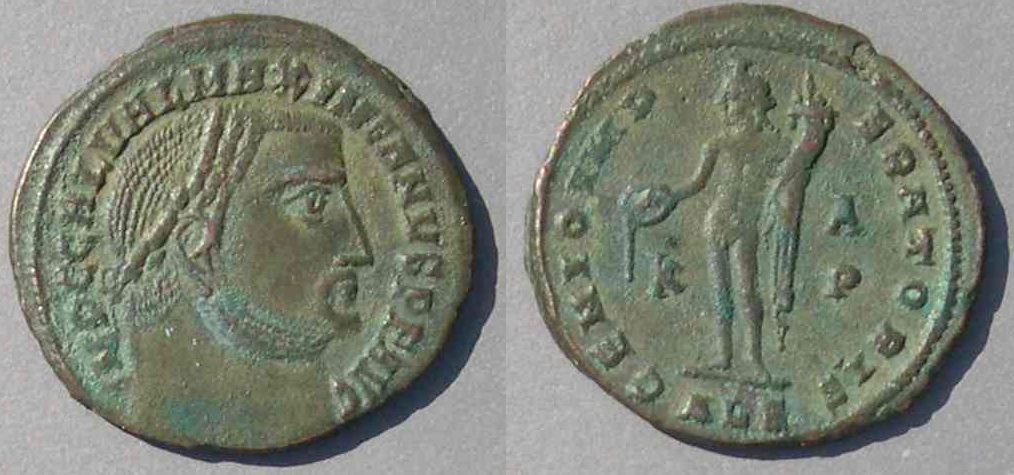
25 mm.
GENIO IMPERATORIS
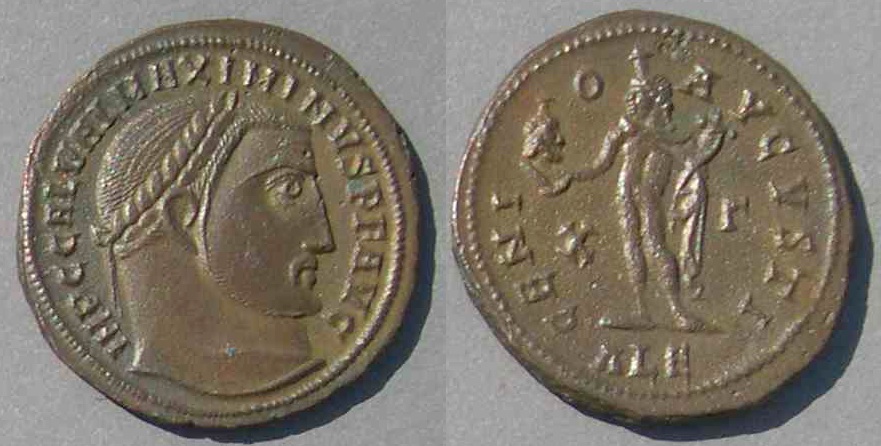
23 mm.
GENIO AVGVSTI
The first obverse legend is: IMP C GAL VAL MAXIMIANVS PF AVG
The second is: IMP C GAL VAL MAXIMINVS PF AVG
So, the first coin is of Galerius as Augustus and the second is of Maximinus II as Augustus.
Summary:
MAXIMIANVS Maximian or Galerius (both always have MAXIMIANVS)
CAES not Maximian
GAL [VAL] Galerius or Maximinus II
MAXIMINVS Maximinus II
MA Maximian
Therefore:
GAL and MAXIMIANVS Galerius
GAL and MAXIMINVS Maximinus II
MAXIMINVS Maximinus II
MA and MAXIMIANVS Maximian
MAXIMIANVS and CAES Galerius
MAXIMINVS and CAES Maximinus II
MAXIMIANVS and AVG not enough to distinguish Maximian and Galerius (Time to consult the reference books!)
Return to the portrait gallery
A page with more about Maximian's name.
If you have comments suggestions for making this page clearer, write me at 
 Distinguishing between Maximian, Galerius, and Maximinus II.
Distinguishing between Maximian, Galerius, and Maximinus II. 














